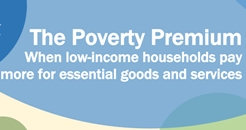 The poverty premium
The poverty premium
You've probably heard the assertion that 'the poor pay more for goods and services'. An immediate example you might think of is bulk buying. As I write this, a large 65 wash pack of Daz washing powder in Tesco's is £7.00 - £1.66 per kg. A small 10 wash pack is £2.00 - £3.08 per kg. That's 86% more per kg.
Which pack do you think is more affordable to those experiencing poverty?
Bristol University's Personal Finance Research Centre took an updated look at this issue and in November 2016 published their findings in a report 'The Poverty Premium - When low-income households pay more for essential goods and services'.
They identify eight types of poverty premium that households experience to varying degrees. However, I was a bit shocked to see that paying extra for small packs as in my example above is not included and yet this must add up to a considerable amount over a year.
The eight types of poverty premium that they say households experience to varying degrees are:
1. Use of fuel prepayment meters (imposed)
Prepayment meters are a more expensive way of paying for domestic fuel compared to paying by monthly direct debit. Even those who switch to the best prepayment meter tariffs pay more.
2. Use of non-standard methods of bill payment for fuel and insurance (choice)
A minority of low-income households pay for their electricity or gas on receipt of monthly or quarterly bills (standard billing) and preferred to pay this way than by monthly direct debit (which is cheaper) in order to retain control of their spending. In relation to insurance, around a third of low-income households pay for their car and home contents insurance monthly (which incurs a premium) because they could not afford to pay annually upfront.
3. Not switched to the best fuel tariff (imposed and choice)
The cheapest fuel tariffs are fixed-term deals paid by monthly direct debit. To get these requires consumers to regularly switch. Lower-income households are less likely to switch and higher rates of digital exclusion make it more difficult for them to do so. Reasons for not switching included risk aversion and the need to retain tight budgeting control, underpinned by the complex tariff structures within the energy market. Those on prepayment meters, or who pay on receipt of bill are excluded from the best tariffs, even if they chose to switch.
4. Paper billing for fuel and telecommunications (choice)
Around a quarter of low-income households in our survey received paper bills for their gas, electricity and landline and/or broadband, with 13 per cent receiving a paper bill for mobile phones. While paper billing can result in additional charges, some respondents preferred to receive paper bills because of a lack of confidence and skills in using the internet and to have their bills in 'black and white' to facilitate record-keeping.
5. Area-based premiums including insurance and access to affordable shops (imposed)
Area-based premiums relate to higher premiums for insurance cover in higher risk areas, where low income households are more likely to live, and greater difficulty accessing good value shops in more deprived (and poorly served) areas.
6. Insurance of individual household items and mobile phones (imposed and choice)
Insurance of individual items encompasses policies for white goods and other household appliances and mobile phones. These can be an expensive way to insure goods compared to taking out comprehensive home contents insurance, but offer an option when households cannot afford to access comprehensive home contents insurance or where the cost of cover is excessive compared with their need for only low levels of cover.
7. Access to money (imposed and choice)
Access to money has three components: the use of fee-charging cash machines; the use of fee-charging cheque-cashing; and the use of prepaid cards as an alternative to a debit or credit card.
8. Higher-cost credit (imposed and choice)
The use of higher-cost credit is driven largely by financial exclusion, lack of affordability, borrowing small amounts, and a desire for close budgeting control with small weekly payments.
The University estimates that the average cost of the poverty premium is £490 per household per year. The average premium for each component takes into account the proportion of households incurring it. In other words, their model doesn’t assume that all low-income households incur all premiums. However, some households are highly exposed i.e. incur most of the premiums.
The £490 is made up, in descending order of premium, as follows:
Not switched to best fuel tariff £233
Area-based premiums £84
Higher-cost credit £55
Use of prepayment meters £38
Non-standard billing methods £33
Insurance for specific items £27
Paper billing £12
Access to money £9
As you can see, the big item is not switching to best fuel tariff. Three-quarters (73 per cent) of low-income households in the survey had not switched fuel supplier in the last two years, and this was higher still among the digitally excluded (83 per cent).
This set me thinking about how churches might help (especially staff helping in debt advice). Why not set up an event at a community space in a local deprived area - 'bring your energy bills to us and see how much you can save'. Sitting with a visitor, using Uswitch, see what the savings might be and help them switch. Moves to prevention, helps them and helps you build relationships. While you are about it you can touch on other things e.g. paper billing.
Download the Poverty Premium report here.
Retweet about this article:
From a report by Bristol University, 24/04/2017